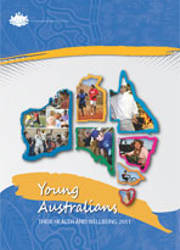Summary
Young Australians: their health and wellbeing 2011 is the fourth in a series of national statistical reports on young people aged 12–24 years produced by the Australian Institute of Health and Welfare (AIHW). This report provides the latest available information on how Australia’s young people are faring according to national indicators of health and wellbeing.
Key findings
Many young Australians are faring well according to the national indicators presented in this report; however, there is considerable scope for further gains, particularly among Aboriginal and Torres Strait Islander young people.
The good news
- Large declines in death rates (mostly due to declines in injury deaths).
- Declines in asthma hospitalisations, notifications for hepatitis (A, B and C) and improved survival for cancer, with survival for melanoma very high.
- Favourable trends in some risk and protective factors, such as declines in smoking and illicit substance use, and most Year 10 and Year 12 students using contraception.
- The majority of young people rate their health as ‘good’, ‘very good’ or ‘excellent’.
- Most young people are achieving national minimum standards for reading, writing and numeracy, are fully engaged in study or work, and have strong support networks.
- Most young people are able to get support from outside the household in times of crisis.
Things to work on
- Rising rates of diabetes and sexually transmissible infections (largely chlamydia), and high rates of mental disorders and, among males, road transport accident deaths.
- Too many young people are overweight or obese, not meeting physical activity or fruit and vegetable guidelines, are drinking at risky or high-risk levels for short-term or long-term harm, are victims of alcohol- or drug-related violence, or are homeless.
- Although there have been improvements in some of these areas, the rates remain too high.
Aboriginal and Torres Strait Islander young people
Indigenous young people are far more likely to be disadvantaged across a broad range of health, community and socioeconomic indicators compared with non-Indigenous young people. They are:
- twice as likely to die from all causes (6 times as likely from assault and 4 times from suicide)
- 10 and 6 times as likely to have notifications for sexually transmissible infections and hepatitis
- 6 times as likely to be teenage mothers
- 6–7 times as likely to be in the child protection system
- 15 times as likely to be in juvenile justice supervision or in prison
- twice as likely to be unemployed or on income support
- 3 times as likely to live in overcrowded housing
- 2–3 times as likely to be daily smokers.
Young people living in remote areas
- have higher death rates
- have more dental decay
- are less likely to access general practitioners
- are less likely to be meet minimum standards for reading, writing and numeracy and to be studying for a qualification
- are more likely to be in jobless families and live in overcrowded housing.
Data gaps
- There are still a number of indicators for which there is a lack of national data, data for relevant age groups or recent available data including sun protection, sexual and reproductive health, community participation, sexual assault, oral health and mental health.
- Some indicators require significant indicator and data development—family functioning, and school relationships and bullying—and there are other areas of emerging concern that may require future indicator development. These include sleep disorders, media and communications, and the effects of climate change.
Summary
Part I Background
- Introduction
- Young people in Australia: demographic overview
- Australian families
Part II Health status and wellbeing
- Physical and mental wellbeing
- Disability and activity limitation
- Deaths
- Mental health
- Injury and poisoning
- Chronic conditions
- Communicable diseases
- Oral health
Part III Factors influencing health
- Overweight and obesity
- Physical activity
- Nutrition
- Sun protection
- Substance use
- Sexual and reproductive health
Part IV Family and community factors
- Family functioning
- Parental health and disability
- Social capital
- Community and civic participation
- School relationships and bullying
- Child protection
- Victims of violence
- Young people and crime
- Environmental tobacco smoke
- Homelessness
- Overcrowded housing
Part V Socioeconomic factors
- Education
- Employment
- Income
- Socioeconomic status of parents
Part VI Health system performance
- Potentially preventable hospitalisations
- Teenage purchase of cigarettes or alcohol
- Survival from melanoma of the skin
- Cervical cancer
- Appropriate use of antibiotics
- Delivery by caesarean section
- General practice consultations
- Emergency department waiting times
- Adverse events treated in hospital
Part VII Aboriginal and Torres Strait Islander young people
- Health and wellbeing of Indigenous young people
Part VIII Data gaps and developments
- Data gaps
- Emerging issues of concern
- New data developments relevant to young people
Appendix 1 Methods
Appendix 2 Data sources
Appendix 3 Abbreviations
End matter: Appendices; Acknowledgments; References; List of tables; List of figures



